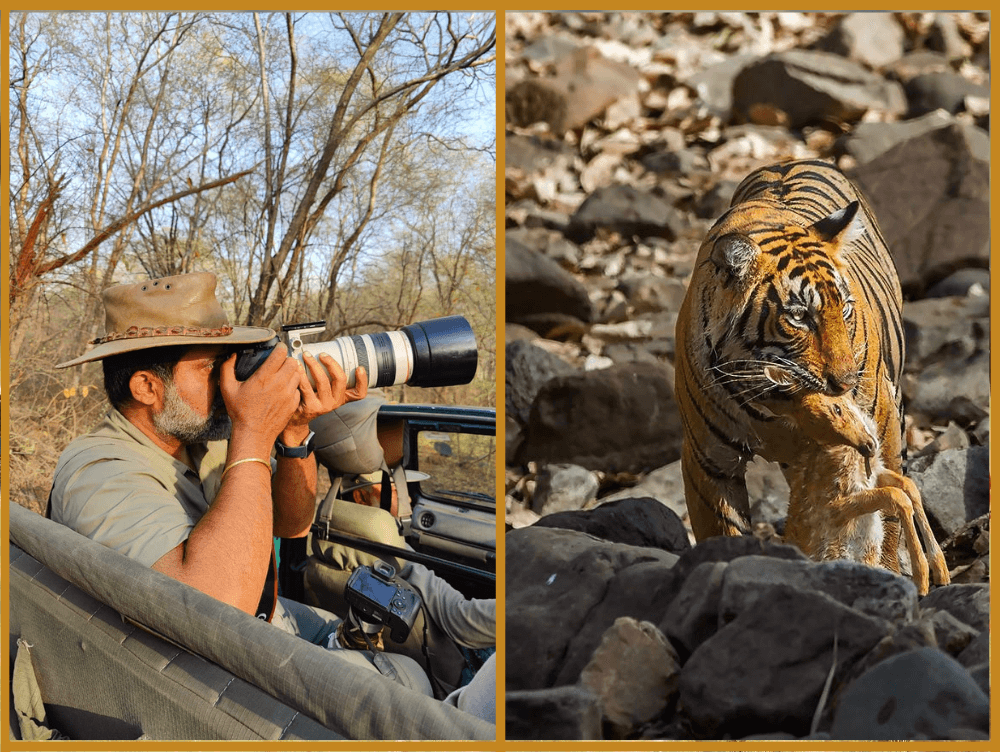
The stillness of the morning shattered by a branch cracking underfoot. Leaves rustling as a soft breeze whispers through the trees. The melodic calling of birds to one another across a grassy meadow. These subtle sounds of the wilderness instantly transport me back to the places I love most. I am Saran Vaid, founder of The Earth Safari, as a professional wildlife photographer for over 15 years, I strive to capture these magical moments on film to share the wonders of nature with others. I've been fortunate to photograph majestic Tigers prowling India's jungles, Big Cats & massive Elephants roaming Africa's open plains, and rare species from remote corners across the globe. Through extensive time photographing in the field, I've gained invaluable insights into mastering wildlife photography. In this article, I'll share the techniques, gear, and philosophies I live by in my passionate pursuit of stunning animal imagery.
Patience & Preparation - The Bedrock of Success
They say “good things come to those who wait.” This rings true time and again in wildlife photography. Preparation is paramount for encountering incredible moments to capture.
I spend hours researching locations, animal behaviors, peak activity times, migration patterns - any clues that help me strategically set myself up for success. Consulting local guides, observing animal signs like tracks or territorial markings, and staking out watering holes or grazing grounds help predict ideal spots.
Once on location, more patience follows. I may sit for hours in a concealed blind waiting for the ideal behavior to emerge. I find observing calmly without expectation yields the best results. Some days I return with only a handful of shots. Others, hundreds of images depicting a magical story. Appreciating each glimpse as a gift reminds me why I fell in love with photography and the natural world.
Technical Proficiency - Master Your Craft
While new photographers often obsess over gear, photographic mastery lies in technical skill honed through practice. Learning to manipulate exposure components adeptly captures wildlife in the best light. A fast shutter speed freezes action. An adjusted aperture artfully blurs or sharpens backgrounds. And judiciously increasing ISO prevents noisy low light shots. With intuitive command over your camera, you can work quickly when fleeting moments arise.
I also spend lots of time mastering panning techniques which track moving subjects smoothly. This keeps animals sharp while the background melts into painterly streaks of color. Whether photographing a soaring raptor or stampeding wildebeest, preparation is power. The more techniques you intuitively understand ahead of time through training, the better your in-field reactions will be.
Essential Gear - Outfitting Yourself for the Wild
While skill matters most, specialized equipment allows capturing scenes impossible with standard gear. Some essentials:
A super telephoto zoom lens (200-400mm) - gets you frame-filling wildlife close-ups from a distance.
A fast DSLR or Mirrorless camera - look for rapid burst shooting modes and quick autofocus.
A rugged tripod with a gimbal head - provides stability and smooth panning/tilting.
Sturdy memory cards with ample storage - wildlife sequences fill cards quickly!
A beanbag - provides a steady field shooting support.
Camouflage clothing - stay hidden when waiting for shy subjects.
And don’t forget extra batteries! Shooting all day eats them up fast. Investing in quality kit for your style of photography gives you creative flexibility.
Field Techniques - Making Magic Happen
While preparation helps stage the scenes, technical skill and artistic vision decide what you actually capture through your lens. Here are some tips I live by in the field:
The Power of Lighting
Watch how morning and evening golden light transforms landscapes. Backlight creates rimmed silhouettes of grazing animals. Sidelight sculpts dimension across contours. Open shade illuminates evenly. Light quality changes by the minute so observe and adapt.
Controlling Exposure
I carefully meter scenes to determine ideal shutter speed, aperture, and ISO combinations. Adjust as required to correctly expose animal subjects while capturing desired effects like blurred motion. Exposure latitude gives room for error with RAW processing later.
Manipulating Depth of Field
Blurring backgrounds aesthetically isolates wildlife subjects. I frame using wider apertures like f/4. Review images at 100% to ensure eyes pin-sharp. For landscapes, narrower apertures like f/16 widen depth of field.
Composing Creatively
Isplitlines, patterns, and negative space artfully arrange elements. Leading lines direct eyes through the scene. Framing devices highlight subjects. Perspective done from ground-level enhances the view. Avoid centering everything - use the rule of thirds. Constantly explore different angles and positions.
Getting Close-ups from Afar
A super telephoto zoom lens frames intimate wildlife portraits without disturbing them. I watch calmly until an animal wanders into an uncluttered spot, then zoom in tight. A shallow depth of field throws backgrounds out of focus.
Capturing Action and Motion
Freezing action requires fast shutter speeds above 1/1000s. Anticipating movements helps time moments. Panning horizontally blurs backgrounds yet keeps subjects sharp. Burst shooting increases chances of nailing peak action.
Post Production - Enhancing Your Vision
After the shoot, hours of processing remain. Carefully culling selects, editing tones and light, selectively sharpening eyes, and creatively enhancing images brings them to their full visual potential. This allows me to fully realize my creative vision. Post work cements the emotional storytelling I aim for.
A Code of Conduct - Leaving No Trace
Photographing wildlife requires prioritizing the well-being of animals and their habitat. I only use designated paths and hides provided in preserves, limiting my footprint. I keep noises and scents to a minimum. If any distress is observed, I immediately leave. We must treasure these subjects not exploit them. Their graceful existence humbles me.
Pursuing Your Passion for the Wild
As you set out with camera in hand to explore nature's marvels, I hope these insights help prepare you to venture forth and immerse yourself fully in the present moment. That is where the true magic unfolds. If you open your spirit to the experience, wonders surround us in the wild places calling us home. Listen to that call. Let it guide you to profound inspiration and joy in pursuing your photography passion. Use your work to reveal new perspectives that inspire greater compassion and conservation. Let your images tell stories that matter. I wish you the utmost wonder and fulfillment on the meaningful journeys ahead.
Saran Vaid is an acclaimed Indian wildlife photographer known for his breathtaking images of Tigers, Big Cats, Elephants, and other exotic species captured in their natural habitats across India and Africa.
